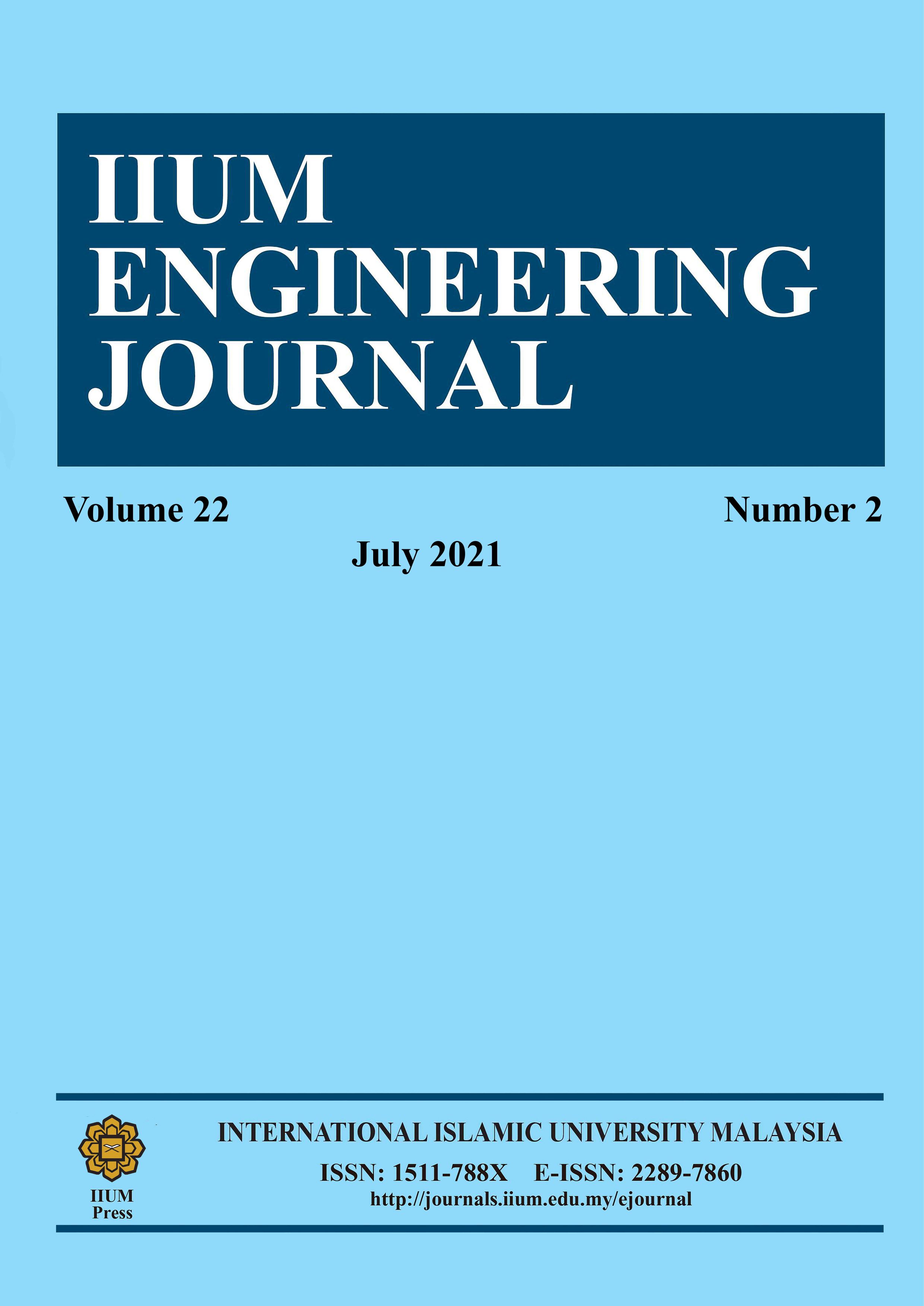MACHINE-LEARNING-BASED EVALUATION OF CORROSION UNDER INSULATION IN FERROMAGNETIC STRUCTURES
DOI:
https://doi.org/10.31436/iiumej.v22i2.1692Keywords:
corrosion under insulation, pulsed eddy current, non-destructive testing, machine learningAbstract
Corrosion under insulation CUI is one of the challenging problems in pipelines used in the gas and oil industry as it is hidden and difficult to detect but can cause catastrophic accidents. Pulsed eddy current (PEC) techniques have been identified to be an effective non-destructive testing (NDT) method for both detecting and quantifying CUI. The PEC signal’s decay properties are generally used in the detection and quantification of CUI. Unfortunately, the well-known inhomogeneity of the pipe material’s properties and the presence of both cladding and insulation lead to signal variation that reduces the effectiveness of the measurement. Current PEC techniques typically use signal averaging in order to improve the signal-to-noise ratio (SNR), with the drawback of significantly-increasing inspection time. In this study, the use of Gaussian process regression (GPR) for predicting the thickness of mild carbon steel plates has been proposed and investigated with no signal averaging used. With mean absolute errors (MAE) of 0.21 mm, results show that the use of GPR provides more accurate predictions compared to the use of the decay coefficient, whose averaged MAE is 0.36 mm. This result suggests that the GPR-based method can potentially be used in PEC NDT applications that require fast scanning.
ABSTRAK: Hakisan di bawah penebat CUI adalah salah satu masalah yang mencabar dalam saluran paip yang digunakan dalam industri gas dan minyak kerana tersembunyi dan sukar dikesan tetapi boleh menyebabkan bencana. Teknik Pulsed eddy current (PEC) telah dikenal pasti sebagai kaedah ujian bukan pemusnah yang berkesan (NDT) untuk mengesan dan mengukur CUI. Sifat kerosakan isyarat PEC umumnya digunakan dalam pengesanan dan pengukuran CUI. Malangnya, sifat tidak tepat yang terkenal dari sifat bahan paip dan kehadiran pelapisan dan penebat menyebabkan variasi isyarat yang mengurangkan keberkesanan pengukuran. Teknik PEC semasa biasanya menggunakan rata-rata isyarat untuk meningkatkan nisbah isyarat-ke-kebisingan (SNR), dengan kelemahan peningkatan masa pemeriksaan dengan ketara. Dalam kajian ini, penggunaan regresi proses Gauss (GPR) untuk meramalkan ketebalan plat keluli karbon ringan telah diusulkan dan diselidiki dan tidak ada rata-rata isyarat yang digunakan. Dengan ralat mutlak (MAE) 0,21 mm, hasil menunjukkan bahawa penggunaan GPR memberikan ramalan yang lebih tepat dibandingkan dengan penggunaan pekali peluruhan, yang rata-rata MAE adalah 0,36 mm. Hasil ini menunjukkan bahawa kaedah berasaskan GPR berpotensi digunakan dalam aplikasi PEC NDT yang memerlukan pengimbasan pantas.
Downloads
Metrics
References
Nafiah F, Tokhi MO, Majidnia S, Rudlin J, Zhao Z, Duan F. (2020) Pulsed Eddy current: Feature extraction enabling in-situ calibration and improved estimation for ferromagnetic application. J. Nondestruct. Eval., 39(52). doi: https://doi.org/10.1007/s10921-020-00699-w. DOI: https://doi.org/10.1007/s10921-020-00699-w
Nicola S, Carreto V, Mentzer RA, Mannan MS. (2013) Corrosion under insulation detection technique. In Proceedings of Corrosion 2013: 17-21 March 2013; Orlando, Florida
Sophian A, Tian G, Fan M. (2017) Pulsed Eddy Current Non-destructive Testing and Evaluation: A Review. Chinese J. Mech. Eng. (English Ed.), 30:500-514 DOI: https://doi.org/10.1007/s10033-017-0122-4
Xu Z, Wu X, Li J, Kang Y. (2012) Assessment of wall thinning in insulated ferromagnetic pipes using the time-to-peak of differential pulsed eddy-current testing signals. NDT E Int., 51:24-29. doi: https://dx.doi.org/10.1016/j.ndteint.2012.07.004. DOI: https://doi.org/10.1016/j.ndteint.2012.07.004
Ulapane N, Nguyen L. (2019) Review of pulsed-Eddy-current signal feature-extraction methods for conductive ferromagnetic material-thickness quantification. Electron., 8(5):470. doi: https://doi.org/10.3390/electronics8050470. DOI: https://doi.org/10.3390/electronics8050470
Ulapane N, Alempijevic A, Calleja TV, Miro JV. (2017) Pulsed Eddy current sensing for critical pipe condition assessment. Sensors, 17(10):2208. doi: https://doi.org/10.3390/s17102208. DOI: https://doi.org/10.3390/s17102208
Buck JA, Kramer C, Lei J, Lepine BA. (2016) Field implementation of a transient Eddy current system for carbon steel pipe thickness measurements. In Proceedings of 6th International CANDU In-Service Inspection Workshop: 15–17 November 2016; Ontario
Cheng W. (2012) Pulsed Eddy current testing of carbon steel pipes’ wall-thinning through insulation and cladding. J. Nondestruct. Eval., 31(3): 215-224. doi: https://doi.org/10.1007/s10921-012-0137-9. DOI: https://doi.org/10.1007/s10921-012-0137-9
Huang C, Xinjun W, Zhiyuan X, Kang Y. (2010) Pulsed Eddy current signal processing method for signal denoising in ferromagnetic plate testing. NDT E Int., 43(7): 648-653. doi: https://doi.org/10.1016/j.ndteint.2010.06.010. DOI: https://doi.org/10.1016/j.ndteint.2010.06.010
Huang C, Wu X. (2015) An improved ferromagnetic material pulsed eddy current testing signal processing method based on numerical cumulative integration. NDT E Int., 69: 35-39. DOI: https://doi.org/10.1016/j.ndteint.2014.09.006
Sophian A, Tian GY, Taylor D, Rudlin J. (2003) Flaw detection and quantification for ferromagnetic steels using pulsed eddy current techniques and magnetization. Laser Metrology and Machine Performance VI, pp 381-390.
Daura LU, Tian GY, Yi Q, Sophian A. (2020) Wireless power transfer-based eddy current non-destructive testing using a flexible printed coil array: WPT based FPC-ECT. Philos. Trans. R. Soc. A Math. Phys. Eng. Sci., 378:20190579 doi: https://doi.org/10.1098/rsta.2019.0579. DOI: https://doi.org/10.1098/rsta.2019.0579
Nafiah F, Sophian A, Khan MR, Zainal Abidin IM. (2018) Quantitative evaluation of crack depths and angles for pulsed eddy current non-destructive testing, NDT E Int., 102:180-188. doi: 10.1016/j.ndteint.2018.11.019. DOI: https://doi.org/10.1016/j.ndteint.2018.11.019
Kernel (Covariance) Function Options [https://www.mathworks.com/help/stats/kernel-covariance-function-options.html]
Downloads
Published
How to Cite
Issue
Section
License
Copyright (c) 2021 IIUM Press

This work is licensed under a Creative Commons Attribution-NonCommercial 4.0 International License.






















